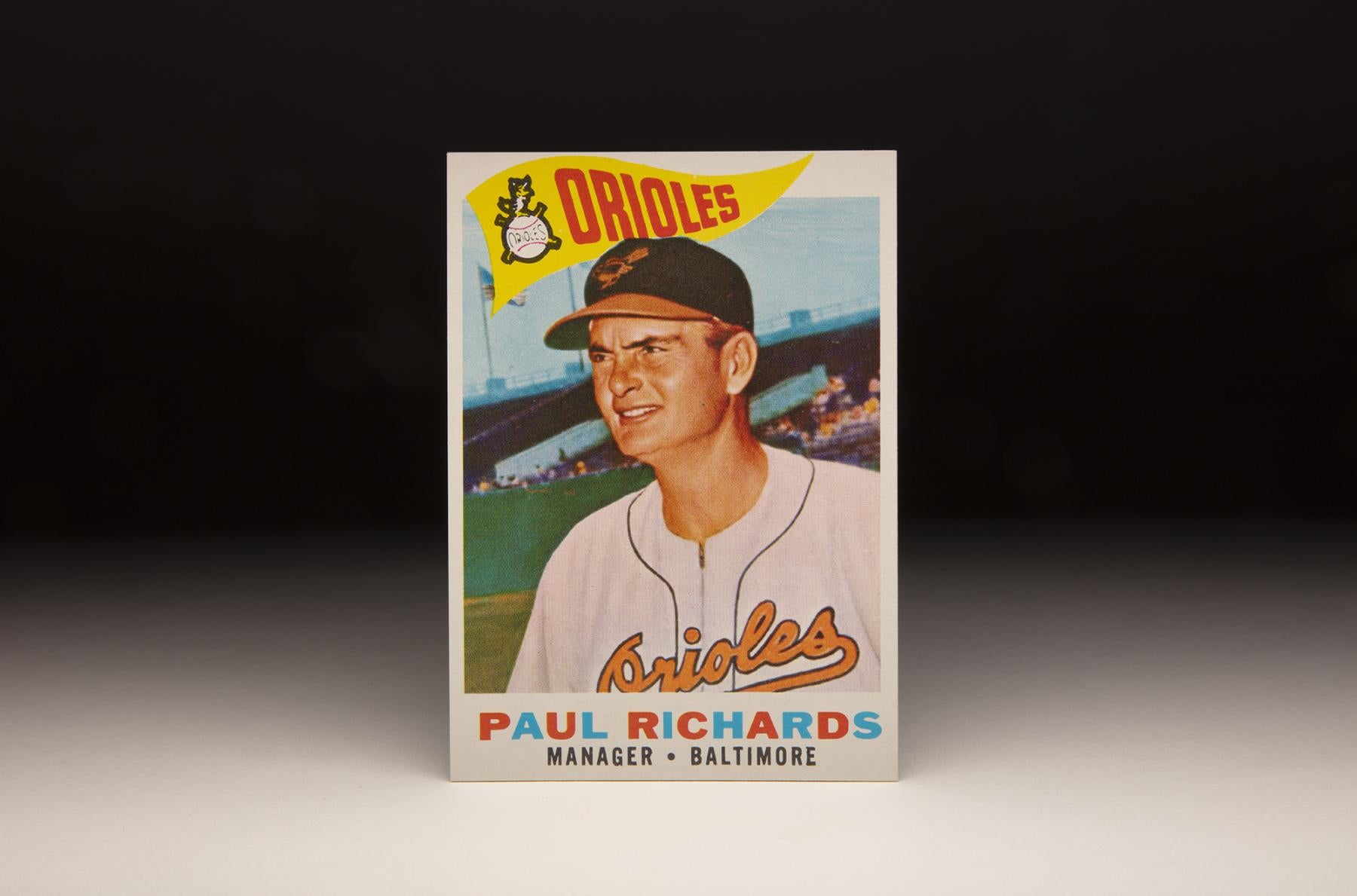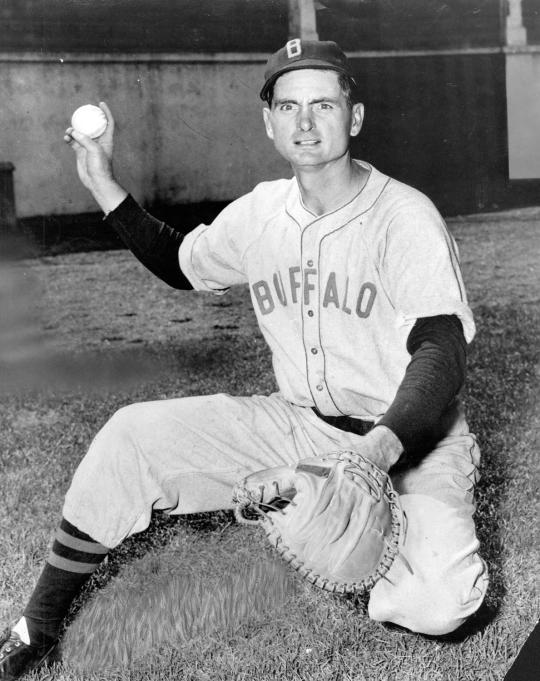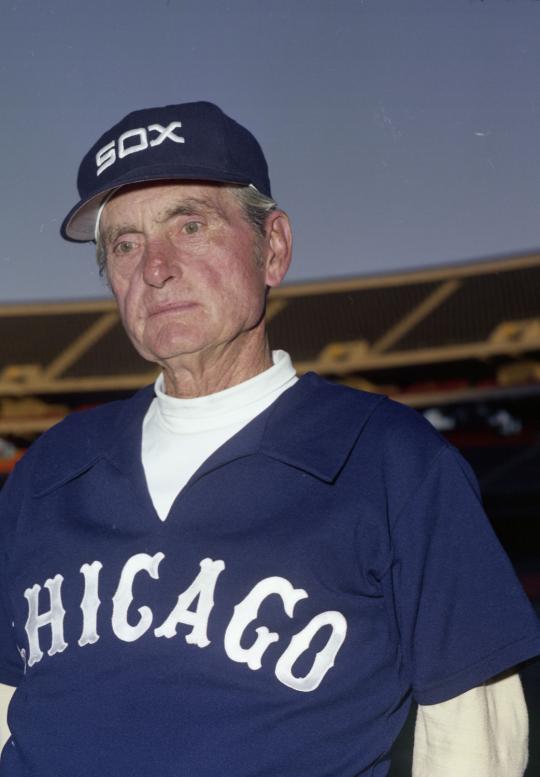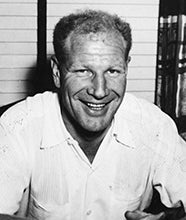- Home
- Our Stories
- #CardCorner: 1960 Topps Paul Richards
#CardCorner: 1960 Topps Paul Richards
Paul Richards began his big league managerial career ahead of his time and ended it trying to adjust to a new era.
In between, Richards inspired loyalty in some and anger in others as one of the toughest leaders of his time.
Hall of Fame Membership
There is no simpler, and more essential, way to demonstrate your support than to sign on as a Museum Member.
Born Nov. 21, 1908, in Waxahachie, Texas, Richards fell in love with baseball as a youngster and starred for Waxahachie High School as the Indians won two state championships. Signing with Brooklyn at the age of 17 in 1926, Richards climbed the minor league ladder while hitting .300 in most of his stops.
A third baseman in high school, Richards became a catcher in 1930 and debuted for the Dodgers on April 17, 1932. But with future Hall of Famer Al López and future super scout Clyde Sukeforth blocking his way behind the plate, the Dodgers sold Richards’ contract to the Minneapolis Millers of the American Association two months later. Then late in that season, the New York Giants acquired Richards from Minneapolis.
As a reserve, Richards helped New York win the 1933 World Series and remained with the team until the Philadelphia Athletics acquired him on May 25, 1935. After hitting .245 in 85 games for the A’s, Connie Mack dealt Richards to the Atlanta Crackers of the Southern Association.
Richards did not appear in a big league game for the next seven seasons. But in Atlanta, Richards got his first opportunity to manage – taking over the team at age 29 as a player/manager in 1938 and leading them to the Southern Association title and a win in the Dixie Series. For his efforts, Richards was named Minor League Manager of the Year by the Sporting News.
Richards remained with the Crackers through the 1942 season, winning another pennant in 1941. Then – with big league rosters decimated by World War II – Richards returned to the majors as a player with the Detroit Tigers in 1943. As the Tigers’ regular catcher, Richards received AL Most Valuable Player votes in both 1944 (finishing 17th) and 1945 (finishing 10th). Detroit won 78 games in 1943, 88 in 1944 (finishing one game behind the pennant-winning Browns in the standings) and 88 again in 1945 while capturing the AL crown.
Richards hit .211 with six RBI in the World Series – one behind team-leader Hank Greenberg – and his three-run double in the first inning of Game 7 gave Detroit a 5-0 lead en route to a 9-3 victory and the championship.
Richards hit .201 in 57 games for the Tigers in 1946 before returning to managing – this time with the Tigers’ Triple-A team in Buffalo. He skippered the Bisons for three years before taking over the Pacific Coast League’s Seattle Rainiers in 1950, going 96-104 in a 200-game season that year.
On Oct. 8, 1950, Richards agreed to take over the Chicago White Sox, who nearly hired Richards after the 1949 campaign. Richards would be the White Sox fifth manager since the start of the 1946 season. Chicago had endured seven straight losing seasons, including a 60-94 finish in 1950.
“We wanted a man with no major league experience, but with minor league experience, so we can raise our own manager,” White Sox general manager Frank Lane told the United Press. “We believe he’ll furnish inspirational leadership. And that’s what we want.”
Richards wasted no time in turning things around at Comiskey Park, leading Chicago to an 81-73 mark in 1951 – including a 14-game winning streak in May. The White Sox would not have another losing season until 1968.
After another 81-win season in 1952, Chicago won 89 games in 1953 and 94 in 1954. But in each season from 1952-54, Richards and the White Sox finished in third place. Richards left the White Sox with nine games left in the 1954 season, taking over as the manager and general manager of the Baltimore Orioles.
“I will run the whole thing,” Richards told the Associated Press.
Richards quickly began rebuilding the Orioles – who had moved from St. Louis prior to the 1954 season – by sending ace pitcher Bob Turley to the Yankees in a trade on Nov. 17, 1954, that featured 17 players. The Orioles received 10 players in the deal while parting with Turley, who led the majors in both strikeouts (185) and walks (181) in 1954.
Richards slowly instilled what became known as “The Oriole Way” throughout the franchise’s minor league system. After five straight losing seasons, Richards’ plan finally paid dividends when the Orioles won 89 games and finished second in the American League in 1960 with a roster of young stars – chief among whom was Brooks Robinson.
One of the early adopters of using on-base percentage to evaluate hitters, Richards preached defense, fundamentals and even pitch counts to anyone who would listen.
But after leading the Orioles to 78 wins in their first 136 games in 1961, Richards left Baltimore to become the general manager of the expansion Houston Colt .45s, which would begin play in 1962. Only days after taking the new job, Richards made a splash by signing Rusty Staub, widely considered the best amateur hitter in the country.
Richards began meticulously building Houston’s farm system, but the big league team lost 96 games every year from 1962-64 and then 97 games in 1965 when they became the Astros and moved into the Astrodome. On Dec. 12, 1965, the Astros decided a change was necessary and Richards was dismissed for the first time in his career as a manager/executive. His contract reportedly ran through 1970.
Richards quickly landed a job with the Braves and was promoted to the team’s general manager role on Jan. 12, 1967. Installing his trusted lieutenant Lum Harris as manager in 1968, the Braves won the inaugural National League West title in 1969 before falling to the Mets in the NLCS.
But after middling seasons in both 1970 and 1971, the Braves reassigned Richards on June 1, 1972, relieving him of the general manager duties and installing Eddie Robinson in that role.
“You don’t think I’m going to be taking orders from Eddie Robinson, do you?” Robinson rhetorically asked the Atlanta Constitution.
Richards gradually removed himself from daily work with the Braves, but came back to baseball in 1976 when Bill Veeck purchased the White Sox and made Richards his manager.
At 67 years of age, however, Richards found the game quite different from when he last managed in 1961.
He moved relief ace Goose Gossage to the rotation in ’76, and Gossage went from 26 saves and a 1.84 ERA in 1975 to a 9-17 record with a 3.94 ERA a year later.
The White Sox went 64-97 in 1976, and Richards was dismissed from his final job as a manager. Richards later worked for the Rangers in their front office before ending his baseball career.
In 12 big league seasons as a manager, Richards was 923-901, finishing above third place only once. But for more than 20 years, Richards was recognized as one of the game’s great thinkers and innovators – a leader who trusted his instincts more than anything else.
“To me, he was the best manager I ever had,” pitcher Billy Pierce told the Chicago Tribune on May 4, 1986, following Richards’ passing. “He would actually teach baseball, and not many managers did that.”
Craig Muder is the director of communications for the National Baseball Hall of Fame and Museum













